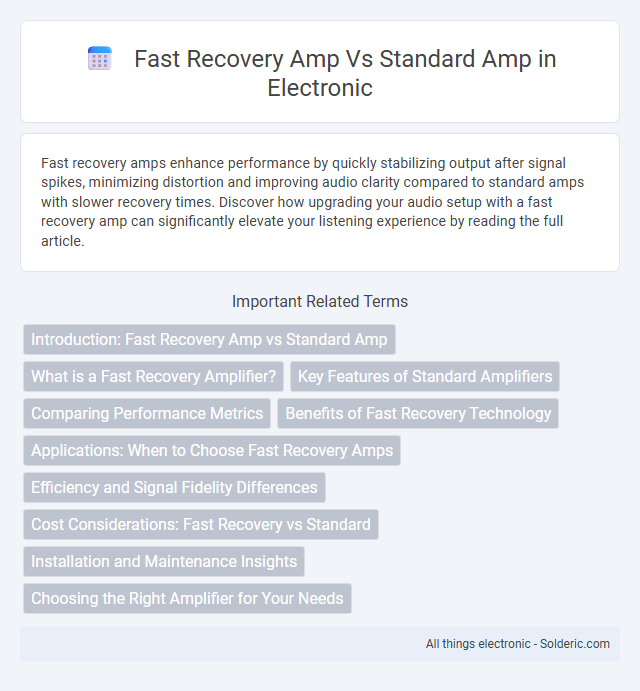Fast recovery amps enhance performance by quickly stabilizing output after signal spikes, minimizing distortion and improving audio clarity compared to standard amps with slower recovery times. Discover how upgrading your audio setup with a fast recovery amp can significantly elevate your listening experience by reading the full article.
Comparison Table
| Feature | Fast Recovery Amplifier | Standard Amplifier |
|---|---|---|
| Recovery Time | Typically < 100 ns, enabling quick signal stabilization | Several microseconds, slower return to baseline |
| Application | High-speed signals, pulse detection, radar systems | General purpose amplification, audio, low-frequency signals |
| Signal Distortion | Minimal during fast transient events | Higher distortion at high frequencies or rapid pulses |
| Bandwidth | Wide bandwidth, supports high-frequency signals | Narrower bandwidth, limited high-frequency response |
| Cost | Typically higher due to specialized components | Lower, more common and simpler design |
| Power Consumption | Generally higher to maintain speedy recovery | Lower power consumption |
Introduction: Fast Recovery Amp vs Standard Amp
Fast Recovery Amplifiers significantly reduce recovery time after signal overloads, enhancing your system's ability to process high-speed signals with minimal distortion. Standard Amplifiers typically exhibit longer recovery times, which can introduce signal degradation and limit performance in high-frequency applications. Choosing a Fast Recovery Amp ensures improved signal integrity and faster response in demanding electronic environments.
What is a Fast Recovery Amplifier?
A Fast Recovery Amplifier is designed to quickly return to normal operation after being driven into saturation, minimizing signal distortion and improving the accuracy of high-speed measurements. Unlike Standard Amplifiers, which can exhibit slower recovery times and increased signal lag, Fast Recovery Amps enable precise handling of rapidly changing input signals. Your choice of amplifier impacts the quality of your data, especially in applications requiring high-frequency or transient signal analysis.
Key Features of Standard Amplifiers
Standard amplifiers typically feature robust design, moderate switching speeds, and reliable performance in general-purpose applications. They often utilize conventional diodes with longer recovery times, resulting in higher switching losses compared to fast recovery amps. Your choice depends on the balance between cost and efficiency, where standard amplifiers excel in durability but may lag in high-speed switching scenarios.
Comparing Performance Metrics
Fast recovery diodes in amplifiers offer significantly reduced reverse recovery time compared to standard diodes, enhancing switching speed and efficiency in high-frequency applications. Your amplifier's overall performance benefits from lower switching losses and improved thermal management due to these optimized recovery characteristics. Standard amplifiers, while reliable, often exhibit slower recovery times, resulting in increased distortion and decreased efficiency under rapid switching conditions.
Benefits of Fast Recovery Technology
Fast recovery amps minimize distortion by quickly restoring normal operation after voltage spikes or overloads, enhancing overall audio clarity and reducing signal degradation. They improve dynamic response, allowing for more precise handling of rapid transient signals in music playback or live sound applications. This technology also boosts amplifier reliability and efficiency, preventing thermal stress and extending component lifespan compared to standard amps.
Applications: When to Choose Fast Recovery Amps
Fast recovery amps excel in applications requiring high-speed switching and minimal power loss, such as in switch-mode power supplies, motor drives, and automotive electronics. Your choice should lean toward fast recovery amps when rapid diode switching prevents voltage spikes and reduces electromagnetic interference, improving overall circuit efficiency. Standard amps are better suited for low-frequency or less demanding applications where switching speed is less critical.
Efficiency and Signal Fidelity Differences
Fast recovery amp designs offer higher efficiency by minimizing power loss during signal transitions, resulting in improved thermal performance and reduced energy consumption compared to standard amps. Signal fidelity in fast recovery amps is enhanced due to faster transient response times, which reduces distortion and preserves waveform integrity during rapid changes. Your choice of amp affects both energy efficiency and audio clarity, with fast recovery amps delivering superior performance in demanding applications.
Cost Considerations: Fast Recovery vs Standard
Fast recovery diodes typically carry a higher upfront cost compared to standard diodes due to their advanced semiconductor materials and design techniques. However, fast recovery amps reduce switching losses and improve energy efficiency, potentially leading to lower operational expenses and longer device lifespan. Evaluating both initial investment and total cost of ownership is crucial when choosing between fast recovery and standard amplification solutions.
Installation and Maintenance Insights
Fast recovery amplifiers feature simplified installation processes due to their advanced circuitry that minimizes signal distortion and power loss, leading to quicker setup times compared to standard amplifiers. Maintenance demands for fast recovery amps are typically lower because their components are designed for durability and efficient thermal performance, reducing the frequency of repairs and replacements. In contrast, standard amplifiers may require more frequent tuning and servicing to maintain optimal output levels and prevent signal degradation.
Choosing the Right Amplifier for Your Needs
Fast recovery amplifiers offer superior efficiency and reduced signal distortion, making them ideal for high-speed switching applications and precision audio systems. Standard amplifiers provide reliable performance and are cost-effective for general-purpose use where ultra-fast response times are less critical. Evaluating your specific requirements, such as signal speed and fidelity, helps you choose the right amplifier that best supports your application and enhances your overall audio or signal processing experience.
Fast recovery amp vs Standard amp Infographic

 solderic.com
solderic.com